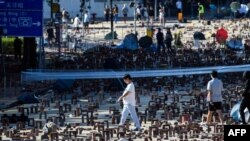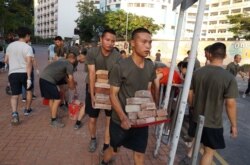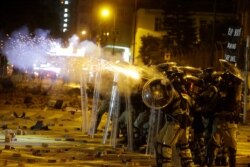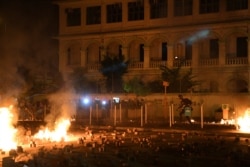Dozens of Chinese People's Liberation Army soldiers helped clear protester barricades from a street Saturday, emerging from their barracks for the first time since protests engulfed the semiautonomous Chinese territory five months ago.
Pro-democracy lawmakers immediately condemned the move as a violation of the Basic Law, Hong Kong's mini-constitution, which forbids interference by mainland Chinese soldiers unless the Hong Kong government formally requests action.
The decision appeared to be Beijing’s latest attempt to gradually increase and normalize Chinese military involvement in Hong Kong, which has seen increased protests over the past week following the first death of a student protester.
Carrying broomsticks and buckets, about 50 PLA soldiers jogged in formation Saturday afternoon from their barracks in the Kowloon neighborhood. The soldiers, dressed in black athletic shorts and khaki T-shirts, removed bricks from a street for about 30 minutes.
Protesters had placed the bricks at Hong Kong Baptist University, one of several campuses across Hong Kong where students this week blocked roads and clashed with police.
A small group of residents and pro-Beijing politicians joined soldiers in the cleanup, according to reports.
It was the first time that PLA soldiers had been seen on Hong Kong's streets during the current pro-democracy protests.
Violation of Basic Law?
A Hong Kong government spokesperson said local authorities did not request PLA help, calling the move purely voluntary, according to public broadcaster RTHK. A PLA spokesperson said the soldiers were simply "coming to the aid" of local residents, the broadcaster said.
Article 14 of the Basic Law stipulates that mainland Chinese military forces "shall not interfere in the local affairs of the Region," but that the Hong Kong government may, when necessary, ask for assistance "in the maintenance of public order and in disaster relief."
In a statement, a group of pro-democracy lawmakers condemned the move as illegal, saying it was meant to "gradually rationalize" PLA operations.
"Although the actions themselves may appear innocuous, the PLA's conduct today is worrying from a constitutional standpoint," Wilson Leung with the Hong Kong Progressive Lawyers Group told VOA. "There's no indication from the Hong Kong government that they have invoked Article 14 and called for the PLA's assistance.
"Thus, there is good reason to think that Article 14 may have been breached," Leung said, calling it a possible further erosion of the "one country, two systems" principle with which Beijing has governed the former British colony.
Last year, PLA troops also left their barracks to help clean up after a typhoon. At the time, Hong Kong officials also said they did not request the assistance.
The PLA occupies about 19 sites, including 12 barracks, in Hong Kong. The exact number of Chinese troops stationed in Hong Kong is unknown, but reports suggest anywhere from 5,000 to 10,000, with Beijing possibly reinforcing those numbers since the protests began.
Since June, Hong Kong has seen massive, regular demonstrations, which started in opposition to a proposed bill that would have allowed Hong Kong citizens to be extradited to the mainland. The protests quickly morphed into wider calls for democracy and opposition to growing Chinese influence.
A smaller group of hardcore protesters, many of whom are college students, also have increasingly engaged in more aggressive tactics — clashing with police, destroying public infrastructure and vandalizing symbols of state power.
Campus takeovers
Over the past week, some students took over university campuses, many of which were closed early for the semester because of the unrest. Students at the sites in some cases collected makeshift weapons, such as bricks, slingshots and Molotov cocktails, which they say are used to defend themselves from police attacks.
At the Chinese University of Hong Kong, police and protesters engaged in a fierce clash late into the night Tuesday. The clash prompted concerns that the violence had entered a new phase, but as of late Saturday, only a small contingent of students remained at many of the campuses.
The protests escalated over the past week, following the first death of a protester, who fell from a building during clashes between protesters and police.















